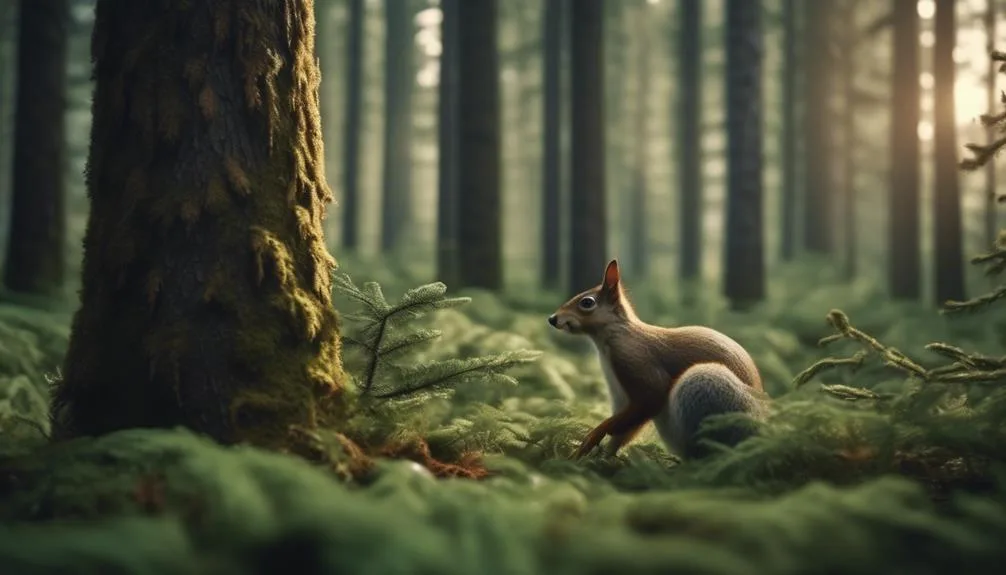Spruce trees are vital for ecosystems and wildlife. They provide shelter and food for various species and contribute to the balance of life in forests.
Their impact on the environment goes beyond just being part of the scenery. Understanding their role reveals their significance to the survival of many species. Without these towering giants, the natural world would be vastly different.
Spruce Trees as Wildlife Habitat
Spruce trees provide essential habitat for a diverse range of wildlife. They offer shelter, nesting sites, and food sources for various species. The dense foliage and sturdy branches of spruce trees create ideal nesting sites for birds such as owls, hawks, and warblers.
These trees also provide crucial shelter and protection for small mammals like squirrels, rabbits, and porcupines. They offer safety from predators and harsh weather conditions.
Additionally, the seeds, buds, and needles of spruce trees serve as important food sources for many animals. This includes deer, moose, and various bird species.
The presence of spruce trees in an ecosystem not only enhances the landscape's beauty but also plays a vital role in supporting the intricate web of life. This is through the provision of essential habitat and resources for wildlife.
Role in Nutrient Cycling
Playing a crucial role in nutrient cycling, the ecosystem's reliance on spruce trees extends beyond their function as wildlife habitats, encompassing their impact on the flow and recycling of essential elements and compounds. Spruce trees play a pivotal role in nutrient recycling, as they contribute to the enrichment of soil through the decomposition of their needles and roots. This process releases organic matter, which enhances soil fertility and supports the growth of other plants. The table below illustrates the key nutrients that spruce trees help recycle and enrich in the soil.
| Nutrient | Role in Soil Enrichment |
|---|---|
| Nitrogen | Supports plant growth |
| Phosphorus | Vital for root development |
| Potassium | Enhances overall plant health |
| Calcium | Essential for cell wall structure |
Through their active participation in nutrient cycling, spruce trees significantly contribute to the overall health and productivity of ecosystems.
Impact on Soil and Water Conservation
Contribute to the conservation of soil and water by understanding the crucial role spruce trees play in maintaining ecosystem balance and sustainability.
Spruce trees help prevent soil erosion by anchoring the soil with their extensive root systems.
Their thick, evergreen needles create a protective layer on the forest floor, reducing the impact of heavy rainfall and minimizing soil runoff.
Additionally, the deep roots of spruce trees enhance water retention by absorbing excess water from the soil and releasing it gradually, contributing to groundwater recharge and maintaining stream flow during dry periods.
This water retention capacity also helps in maintaining soil moisture levels, which is vital for supporting the growth of other plant species and sustaining the diverse wildlife that depends on these ecosystems.
Understanding the impact of spruce trees on soil and water conservation is essential for preserving the overall health of ecosystems.
Contribution to Biodiversity
Enhancing the richness of plant and animal species, spruce trees create a thriving environment for diverse wildlife within their ecosystems. The dense foliage and large, sturdy branches of spruce trees offer a safe haven for various bird species, while their fallen needles provide shelter for small mammals and insects. The intricate root systems of these trees also contribute to soil stability, preventing erosion and creating microhabitats for fungi and soil-dwelling organisms. Furthermore, the presence of spruce trees encourages species interaction, as they serve as a meeting point for different organisms within the ecosystem. In addition to this, the preservation of spruce tree habitats is crucial for maintaining biodiversity, ensuring the survival of numerous plant and animal species that rely on these trees for sustenance and shelter.
| Benefits of Spruce Trees in Biodiversity | Description |
|---|---|
| Species Interaction | Spruce trees facilitate interactions between various organisms, promoting a thriving ecosystem. |
| Habitat Preservation | The presence of spruce trees preserves vital habitats for numerous plant and animal species, contributing to overall biodiversity. |
Influence on Climate Regulation
The intricate root systems of spruce trees not only provide stability to the ecosystem but also play a crucial role in climate regulation through their impact on soil health and carbon sequestration. Here's how spruce trees influence climate regulation:
- Carbon Sequestration: Spruce trees absorb and store significant amounts of carbon dioxide, helping to mitigate the greenhouse effect and reduce the impact of climate change.
- Temperature Moderation: The dense foliage of spruce trees provides shade and helps to moderate temperatures, creating a more comfortable and stable environment for various species.
- Air Quality: By filtering pollutants and releasing oxygen, spruce trees contribute to improved air quality, benefiting both wildlife and humans.
- Greenhouse Gas Mitigation: Through their ability to sequester carbon, spruce trees help reduce the concentration of greenhouse gases in the atmosphere, ultimately supporting a healthier planet.
Conclusion
As we wander through spruce forests, let's pause to acknowledge the vital role these trees play in sustaining diverse wildlife, nurturing the environment, and preserving the delicate balance of our ecosystems.
Their towering presence isn't merely a sight to behold but a fundamental pillar of the intricate web of life.
Let's cherish and protect these guardians of nature for the well-being of all species that depend on them.

My interest in trees started when I first saw the giant sequoias in Yosemite.
I was a teenager then, and I remember thinking, “I need to learn more about this.”
That moment stuck with me.
A few years later, I went on to study forestry at Michigan Tech.
Since graduating, I’ve worked in a mix of hands-on tree care and community education.
I’ve spent over ten years helping people understand how to plant, maintain, and protect the trees in their neighborhoods.
I don’t see trees as just part of the landscape.
They are living things that make a real difference in our daily lives.
